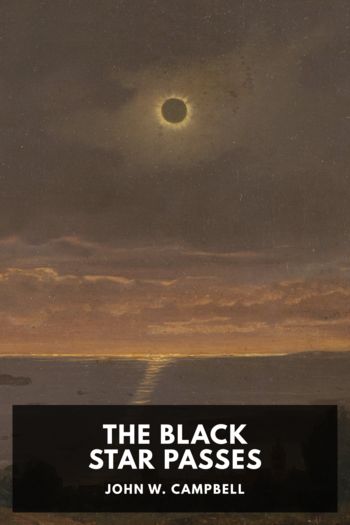The Black Star Passes - John W. Campbell (reading cloud ebooks txt) 📗

- Author: John W. Campbell
Book online «The Black Star Passes - John W. Campbell (reading cloud ebooks txt) 📗». Author John W. Campbell
“Now we’ll see what we will see!” With a confident smile Arcot switched on the current of the big magnet. At once a terrific magnetic flux was set up through the light-metal. He took the little compressed-air saw, and applied it to the crystal plate. The smooth hiss of the air deepened to a harsh whine as the load came on it, then the saw made contact with the refractory plate.
Unbelievingly Wade saw the little diamond-edge saw bite its way slowly but steadily into the plate. In a moment it had cut off a little corner of the light-matter, and this fell with a heavy thud to the magnet pole, drawn down by the attraction of the magnet and by gravity.
Shutting off the magnet, Arcot picked up a pair of pliers and gripped the little fragment.
“Whew—light-metal certainly isn’t light metal! I’ll bet this little scrap weights ten pounds! We’ll have to reduce it considerably before we can use it. But that shouldn’t be too difficult.”
By using the magnet and several large diamond faceplates they were able to work the tough material down to a thin sheet; then with a heavy press, they cut some very small fragments, and with these, determined the specific gravity.
“Arcot,” Wade asked finally, “just how does the magnet make that stuff tractable? I’m not physicist enough to figure out what takes place inside the material.”
“Magnetism worked as it did,” Arcot explained, “because in this light-matter every photon is affected by the magnetism, and every photon is given a new motion. That stuff can be made to go with the speed of light, you know. It’s the only solid that could be so affected. This stuff should be able, with the aid of a molecular motion beam, which will make all the photons move in parallel paths, to move at the full speed of each photon—186,000 miles a second. The tremendous speed of these individual photons is what makes the material so hard. Their kinetic impulse is rather considerable! It’s the kinetic blow that the molecules of a metal give that keeps other metal from penetrating it. This simply gives such powerful impulse that even diamonds wouldn’t cut it.
“You know that an iron saw will cut platinum readily, yet if both are heated to say, 1,600 degrees, the iron is a liquid, and the platinum very soft—but now the platinum cuts through the iron!
“Heat probably won’t have any effect on this stuff, but the action of the magnet on the individual photons corresponds to the effect of the heat on the individual atoms and molecules. The mass is softened, and we can work it. At least, that’s the way I figure it out.
“But now, Wade, I wish you’d see if you can determine the density of the stuff. You’re more used to those determinations and that type of manipulation than we are. When you get through, we may be able to show you some interesting results ourselves!”
Wade picked up a tiny chip of the light-metal and headed for his own laboratory. Here he set up his Jolly balance, and began to work on the fragment. His results were so amazing that he checked and rechecked his work, but always with the same answer. Finally he returned to the main lab where Arcot and Morey were busy at the construction of a large and complicated electrostatic apparatus.
“What did you find?” called out Arcot, as he saw Wade reenter the room. “Hold your report a second and give us a hand here, will you? I have a laboratory scale apparatus of the type the Kaxorians used in the storage of light. They’ve known, ever since they began working with them, that their machines would release the energy with more than normal violence, if certain changes were made in them. That is, the light condenser, the device that stored the photons so close to each other, would also serve to urge them apart. I’ve made the necessary changes, and now I’m trying to set up the apparatus to work on solid light-matter. It was developed for gaseous material, and it’s a rather tricky thing to change it over. But I think we’ve almost got it.
“Wade, will you connect that to the high frequency oscillator there—no—through that counterbalanced condenser. We may have to change the oscillator frequency quite a bit, but a variable condenser will do that.
“Now, what results did you get?”
Wade shook his head doubtfully. “We all know it’s amazing stuff—and of course, it must be heavy—but still—well, anyway, I got a density of 103.5!”
“Whewww—103.5! Lord! That’s almost five times as heavy as the heaviest metal hitherto known. There’s about half a cubic foot of the material; that would mean about 4,000 pounds for the whole mass, or two tons. No wonder we couldn’t lift the plate!”
They stopped their work on the Kaxorian apparatus to discuss the amazing results of the density test, but now they fell to again, rapidly assembling the device, for each was a trained experimenter. With all but the final details completed, Arcot stood back and surveyed their handiwork.
“I think we’ll have enough urge to cause disintegration right here,” he said, “but I want to make sure, and so, before we set up the case over it, I think we may as well put that big magnet in place, and have it there to help in the work of disintegration, if need be.”
At last the complete apparatus was set up, and the tiny bit of light-matter they were to work on was placed on the table of a powerful Atchinson projector microscope, the field of view being in the exact center of the field of both the magnet and the coil. Carefully, then, step by step, Arcot, Morey and Wade went over their work, checking and rechecking.
“Well, we’re ready,” said Arcot finally, as he placed the projector screen in position and dimmed the lights in the room. A touch of the switch, and the projection screen was illuminated with the greatly enlarged image





Comments (0)